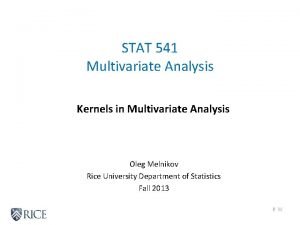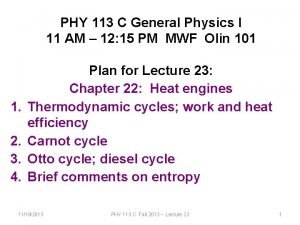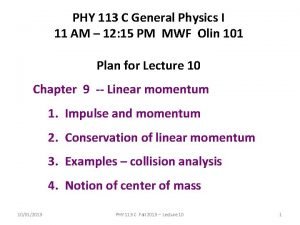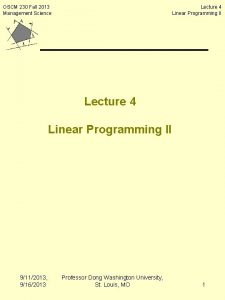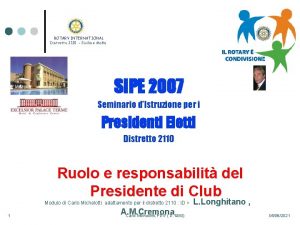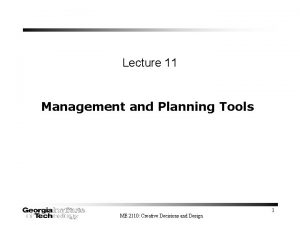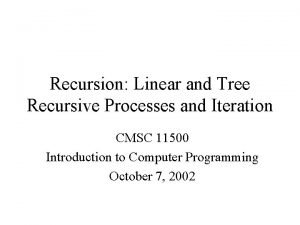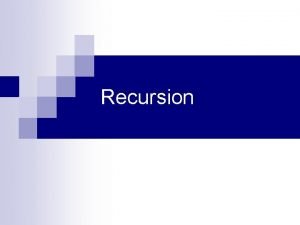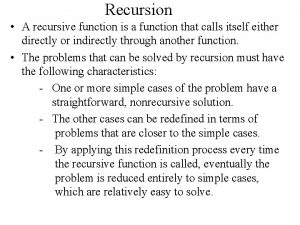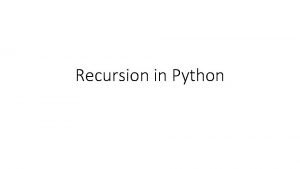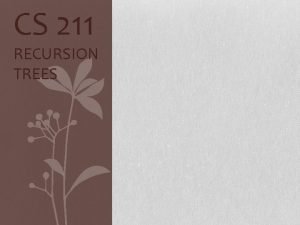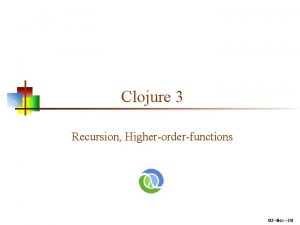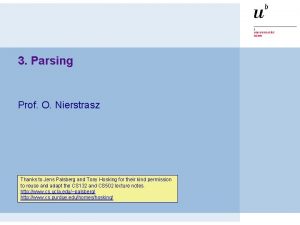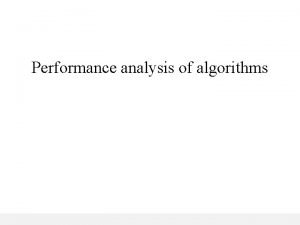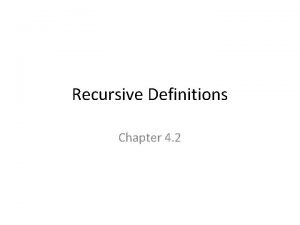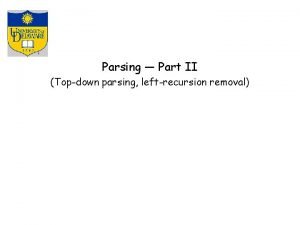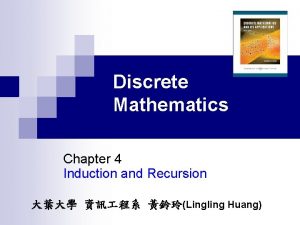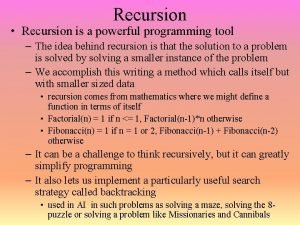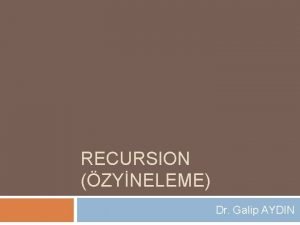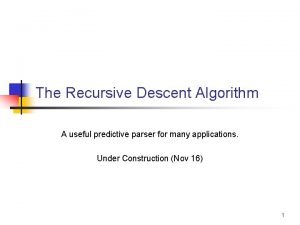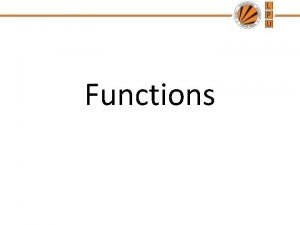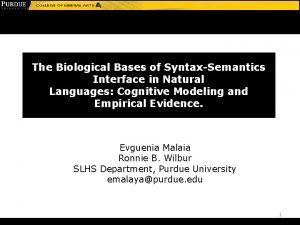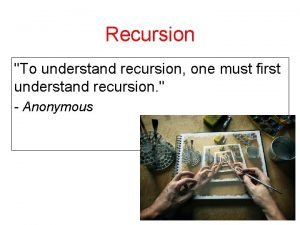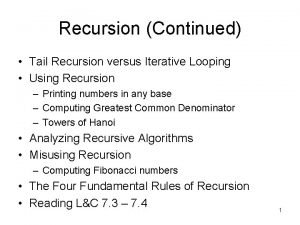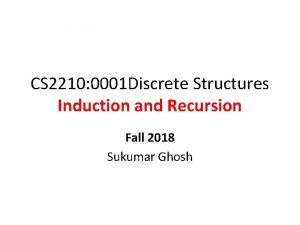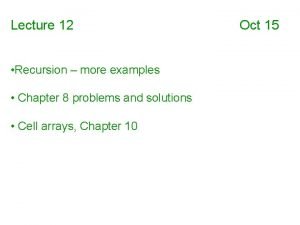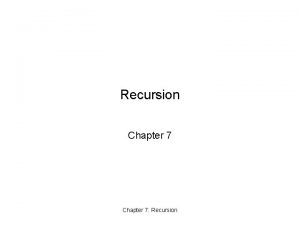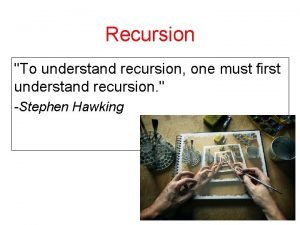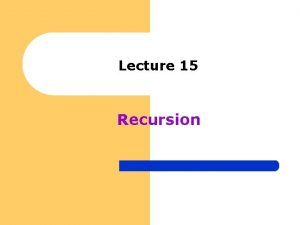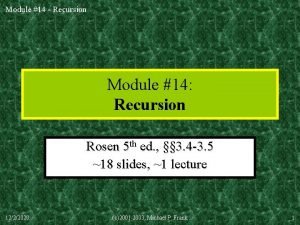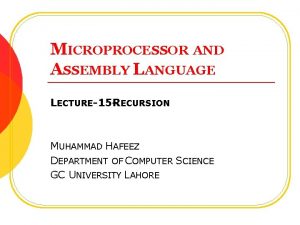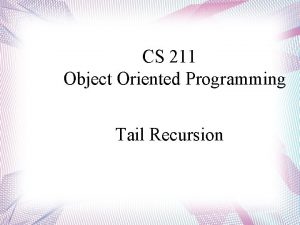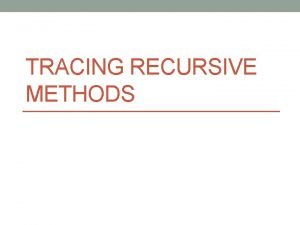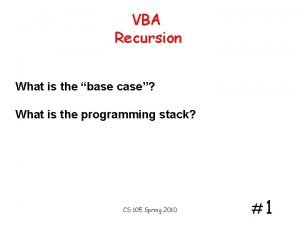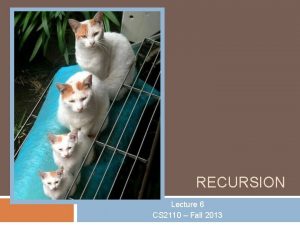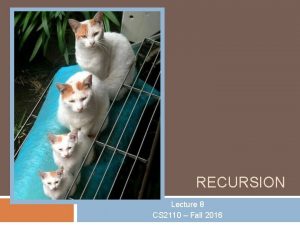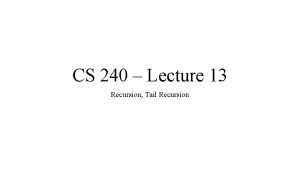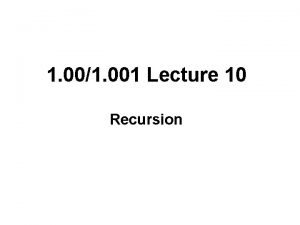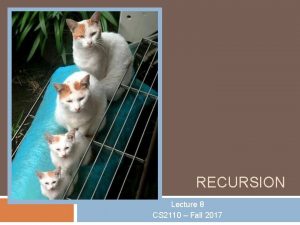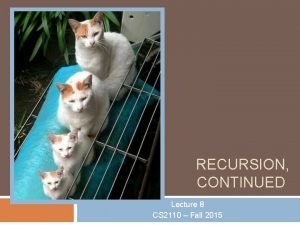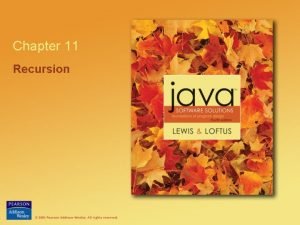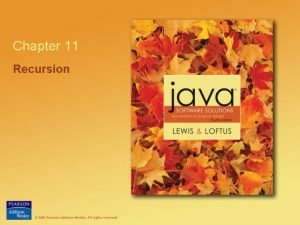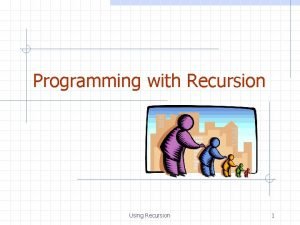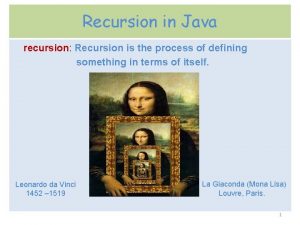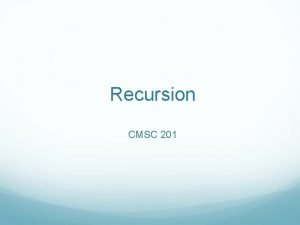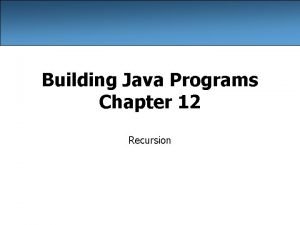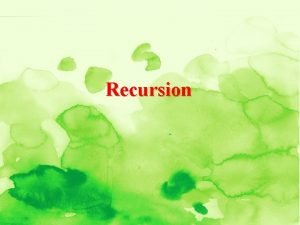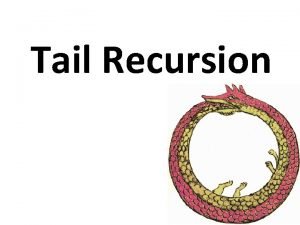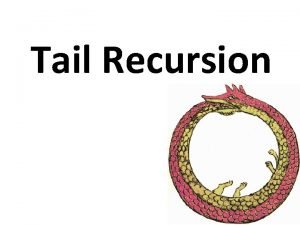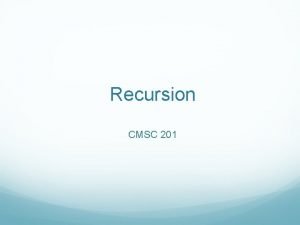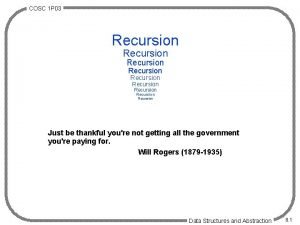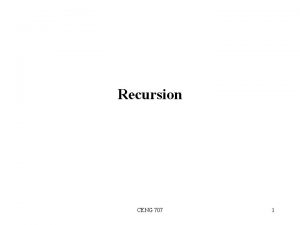RECURSION Lecture 6 CS 2110 Fall 2013 Overview















































![After Memoization 48 /** For 0 <= k < cached. size(), cached[k] = fib(k) After Memoization 48 /** For 0 <= k < cached. size(), cached[k] = fib(k)](https://slidetodoc.com/presentation_image_h2/0bdb1be0a1ddaa0f5a7e53530b605958/image-48.jpg)


- Slides: 50

RECURSION Lecture 6 CS 2110 – Fall 2013

Overview references to sections in text 2 Note: We’ve covered everything in Java. Summary. pptx! What is recursion? 7. 1 -7. 39 slide 1 -7 Base case 7. 1 -7. 10 slide 13 How Java stack frames work 7. 8 -7. 10 slide 28 -32 Homework. Copy our “sum the digits” method but comment out the base case. Now run it: what happens in Eclipse? Now restore the base case. Use Eclipse in debug mode and put a break statement on the “return” of the base case. Examine the stack and look at arguments to each level of the recursive call.

Recursion 3 Arises in two forms in computer science � Recursion as a mathematical tool for defining a function in terms of itself in a simpler case � Recursion as a programming tool. You’ve seen this previously but we’ll take it to mind-bending extremes (by the end of the class it will seem easy!) Mathematical induction is used to prove that a recursive function works correctly. This requires a good, precise function specification. See this in a later lecture.

4 Recursion as a math technique Broadly, recursion is a powerful technique for defining functions, sets, and programs A few recursively-defined functions and programs � factorial � combinations � exponentiation (raising to an integer power) Some recursively-defined sets � grammars � expressions � data structures (lists, trees, . . . )

5 Example: Sum the digits in a number /** return sum of digits in n. * Precondition: n >= 0 */ public static int sum(int n) { sum calls itself! if (n < 10) return n; // { n has at least two digits } // return first digit + sum of rest return n%10 + sum(n/10); } E. g. sum(87012) = 2+(1+(0+(7+8))) = 18

Example: Is a string a palindrome? 6 /** = "s is a palindrome" */ public static boolean is. Pal(String s) { if (s. length() <= 1) Substring from return true; s[1] to s[n-1] // { s has at least 2 chars } int n= s. length()-1; return s. char. At(0) == s. char. At(n) && is. Pal(s. substring(1, n)); } r a c e c a r is. Pal(“racecar”) = true is. Pal(“pumpkin”) = false a c e c e

Example: Count the e’s in a string 7 /** = number of times c occurs in s */ public static int count. Em(char c, String s) { if (s. length() == 0) return 0; Substring s[1. . ], // { s has at least 1 character } if (s. char. At(0) != c) return count. Em(c, s. substring(1)); i. e. s[1], …, s(s. length()-1) // { first character of s is c} return 1 + count. Em (c, s. substring(1)); } count. Em(‘e’, “it is easy to see that this has many e’s”) = 4 count. Em(‘e’, “Mississippi”) = 0

8 Example: The Factorial Function (n!) Define n! = n·(n-1)·(n-2)··· 3· 2· 1 read: “n factorial” E. g. 3! = 3· 2· 1 = 6 Looking at definition, can see that n! = n * (n-1)! By convention, 0! = 1 The function int that gives n! on input n is called the factorial function

A Recursive Program 9 0! = 1 n! = n·(n-1)!, n > 0 /** = n!. Precondition: n >= 0 */ static int fact(int n) { if (n = = 0) return 1; // { n > 0 } return n*fact(n-1); }

General Approach to Writing Recursive Functions 10 1. Find base case(s) – small values of n for which you can just write down the solution (e. g. 0! = 1) 2. Try to find a parameter, say n, such that the solution for n can be obtained by combining solutions to the same problem using smaller values of n (e. g. (n-1) in our factorial example) 3. Verify that, for any valid value of n, applying the reduction of step 1 repeatedly will ultimately hit one of the base cases

Example: Tower of Hanoi Legend has it that there were three diamond needles set into the floor of the temple of Brahma in Hanoi. Stacked upon the leftmost needle were 64 golden disks, each a different size, stacked in concentric order:

A Legend The priests were to transfer the disks from the first needle to the second needle, using the third as necessary. But they could only move one disk at a time, and could never put a larger disk on top of a smaller one. When they completed this task, the world would end!

To Illustrate For simplicity, suppose there were just 3 disks, and we’ll refer to the three needles as A, B, and C. . . Since we can only move one disk at a time, we move the top disk from A to B.

Example For simplicity, suppose there were just 3 disks, and we’ll refer to the three needles as A, B, and C. . . We then move the top disk from A to C.

Example (Ct’d) For simplicity, suppose there were just 3 disks, and we’ll refer to the three needles as A, B, and C. . . We then move the top disk from B to C.

Example (Ct’d) For simplicity, suppose there were just 3 disks, and we’ll refer to the three needles as A, B, and C. . . We then move the top disk from A to B.

Example (Ct’d) For simplicity, suppose there were just 3 disks, and we’ll refer to the three needles as A, B, and C. . . We then move the top disk from C to A.

Example (Ct’d) For simplicity, suppose there were just 3 disks, and we’ll refer to the three needles as A, B, and C. . . We then move the top disk from C to B.

Example (Ct’d) For simplicity, suppose there were just 3 disks, and we’ll refer to the three needles as A, B, and C. . . We then move the top disk from A to B.

Example (Ct’d) For simplicity, suppose there were just 3 disks, and we’ll refer to the three needles as A, B, and C. . . and we’re done! The problem gets more difficult as the number of disks increases. . .

Our Problem Today’s problem is to write a program that generates the instructions for the priests to follow in moving the disks. While quite difficult to solve iteratively, this problem has a simple and elegant recursive solution.

General Approach to Writing Recursive Functions 22 1. Find base case(s) – small values of n for which you can just write down the solution (e. g. 0! = 1) 2. Try to find a parameter, say n, such that the solution for n can be obtained by combining solutions to the same problem using smaller values of n (e. g. (n-1) in our factorial example) 3. Verify that, for any valid value of n, applying the reduction of step 1 repeatedly will ultimately hit one of the base cases

Design Basis: What is an instance of the problem that is trivial? n == 1 Since this base could occur when the disk is on any needle, we simply output the instruction to move the top disk from A to B.

Design Basis: What is an instance of the problem that is trivial? n == 1 Since this base could occur when the disk is on any needle, we simply output the instruction to move the top disk from A to B.

Design (Ct’d) Induction Step: n > 1 How can recursion help us out? a. Recursively move n-1 disks from A to C.

Design (Ct’d) Induction Step: n > 1 How can recursion help us out? b. Move the one remaining disk from A to B.

Design (Ct’d) Induction Step: n > 1 How can recursion help us out? c. Recursively move n-1 disks from C to B. . .

Design (Ct’d) Induction Step: n > 1 How can recursion help us out? d. We’re done!

Tower of Hanoi: Code void Hanoi(int n, string a, string b, string c) { if (n == 1) /* base case */ Move(a, b); else { /* recursion */ Hanoi(n-1, a, c, b); Move(a, b); Hanoi(n-1, c, b, a); } }

Tower of Hanoi on Robot! 30

The Fibonacci Function 31 Mathematical definition: fib(0) = 0 two base cases! fib(1) = 1 fib(n) = fib(n - 1) + fib(n - 2), n ≥ 2 Fibonacci sequence: 0, 1, 1, 2, 3, 5, 8, 13, … Fibonacci (Leonardo /** = fibonacci(n). Pre: n >= 0 */ Pisano) 1170 -1240? static int fib(int n) { if (n <= 1) return n; Statue in Pisa, Italy // { 1 < n } Giovanni Paganucci return fib(n-2) + fib(n-1); 1863 }

Recursive Execution /** = fibonacci(n) …*/ static int fib(int n) { if (n <= 1) return n; // { 1 < n } return fib(n-2) + fib(n-1); } 32 Execution of fib(4): fib(4) fib(2) fib(0) fib(1) fib(3) fib(1) fib(2) fib(0) fib(1)

33 Non-Negative Integer Powers an = a·a·a···a (n times) Alternative description: � a 0 =1 � an+1 = a·an /** = an. Pre: n >= 0 */ static int power(int a, int n) { if (n == 0) return 1; return a*power(a, n-1); }

A Smarter Version 34 Power computation: � a 0 = 1 � If n is nonzero and even, an = (a*a)n/2 � If n is nonzero, an = a * an-1 Java note: For ints x and y, x/y is the integer part of the quotient Judicious use of the second property makes this a logarithmic algorithm, as we will see Example: 38 = (3*3) * (3*3) = (3*3) 4

Smarter Version in Java 35 n = 0: a 0 = 1 n nonzero and even: an = (a*a)n/2 n nonzero: an = a·an-1 /** = a**n. Precondition: n >= 0 */ static int power(int a, int n) { if (n == 0) return 1; if (n%2 == 0) return power(a*a, n/2); return a * power(a, n-1); }

Build table of multiplications 36 n n 0 mults 0 1 2**0 1 2 2**1 2 3 4 3 2**2 3 5 4 6 4 7 4 8 2**3 9 4 5 … 16 2**4 5 Start with n = 0, then n = 1, etc. For each, calculate number of mults based on method body and recursion. See from the table: For n a power of 2, n = 2**k, only k+1 = (log n) + 1 mults For n = 2**15 = 32768, only 16 mults! static int power(int a, int n) { if (n == 0) return 1; if (n%2 == 0) return power (a*a, n/2); return a * power (a, n-1); }

37 How Java “compiles” recursive code Key idea: � Java uses a stack to remember parameters and local variables across recursive calls � Each method invocation gets its own stack frame A stack frame contains storage for � Local variables of method � Parameters of method � Return info (return address and return value) � Perhaps other bookkeeping info

Stacks 38 stack grows top element 2 nd element top-of-stack pointer 3 rd element . . . bottom element Like a stack of dinner plates You can push data on top or pop data off the top in a LIFO (last-in-first-out) fashion A queue is similar, except it is FIFO (first-in-first-out)

39 Stack Frame A new stack frame is pushed with each recursive call a stack frame The stack frame is popped when the method returns Leaving a return value (if there is one) on top of the stack local variables a, n parameters retval return info

Example: power(2, 5) 40 (h. P = ) ? (n = ) 1 (a = ) 2 (retval = ) 1 (h. P = ) 1 (n = ) 1 (a = ) 2 return info (h. P = ) ? (n = ) 2 (a = ) 2 (retval = ) 2 (h. P = ) 2 (n = ) 2 (a = ) 2 return info (h. P = ) ? (n = ) 5 (a = ) 2 (retval = ) 4 (h. P = ) 4 (n = ) 5 (a = ) 2 return info return info h. P: short for half. Power (retval = ) 32

How Do We Keep Track? 41 Many frames may exist, but computation occurs only in the top frame � The ones below it are waiting for results The hardware has nice support for this way of implementing function calls, and recursion is just a kind of function call

Conclusion 42 Recursion is a convenient and powerful way to define functions Problems that seem insurmountable can often be solved in a “divide-and-conquer” fashion: � Reduce a big problem to smaller problems of the same kind, solve the smaller problems � Recombine the solutions to smaller problems to form solution for big problem Important application (next lecture): parsing

Extra Slides 43

A cautionary note 44 Keep in mind that each instance of the recursive function has its own local variables Also, remember that “higher” instances are waiting while “lower” instances run Do not touch global variables from within recursive functions � Legal … but a common source of errors � Must have a really clear mental picture of how recursion is performed to get this right!

45 Memoization (fancy term for “caching”) Memoization is an optimization technique used to speed up computer programs by having function calls avoid repeating the calculation of results for previously processed inputs. � First time the function is called, save result � Next times, look up the result Assumes a “side-effect free” function: The function just computes the result, it doesn’t change things If the function depends on anything that changes, must “empty” the saved results list

One thing to notice: Fibonacci 46 This way of computing the Fibonacci function is elegant but inefficient It “recomputes” answers again and again! To improve speed, need to save known answers in a table! fib(4) � One entry per answer � Such a table is called a cache fib(2) fib(3) fib(0) fib(1) fib(2) fib(0) fib(1)

47 Adding Memoization to our solution Before memoization: static int fib(int n) { if (n <= 1) return n; return fib(n-2) + fib(n-1); } The list used to memoize /** For 0 <= k < cached. size(), cached[k] = fib(k) */ static Array. List<Integer> cached= new Array. List<Integer>();
![After Memoization 48 For 0 k cached size cachedk fibk After Memoization 48 /** For 0 <= k < cached. size(), cached[k] = fib(k)](https://slidetodoc.com/presentation_image_h2/0bdb1be0a1ddaa0f5a7e53530b605958/image-48.jpg)
After Memoization 48 /** For 0 <= k < cached. size(), cached[k] = fib(k) */ static Array. List<Integer> cached= new Array. List<Integer>(); static int fib(int n) { if (n < cached. size()) return cached. get(n); int v; if (n <= 1) This works because of definition of v= n; cached else v= fib(n-2) + fib(n-1); if (n == cached. size()) This appends v to cached. add(v); cached, keeping return v; cached’s definition true }

Notice the development process 49 We started with the idea of recursion Created a very simple recursive procedure Noticed it will be slow because it wastefully recomputes the same thing again and again We made it a bit more complex but gained a lot of speed in doing so This is a common software engineering pattern

Why did it work? 50 This cached list “works” because for each value of n, either cached. get(n) is still undefined or has fib(n) Takes advantage of the fact that an Array. List cached@BA 8900, size=5 adds elements at the end and indexes from 0 0 1 1 cached. get(0) = 0 cached. get(1) = 1 2 3 … cached. get(n) = fib(n) Property of our code: cached. get(n) accessed after fib(n) computed
 To understand recursion you must understand recursion
To understand recursion you must understand recursion 01:640:244 lecture notes - lecture 15: plat, idah, farad
01:640:244 lecture notes - lecture 15: plat, idah, farad Fall 2013
Fall 2013 Fall 2013
Fall 2013 Collision physics
Collision physics Fall 2013
Fall 2013 Millog lyly
Millog lyly Aqap 2110 edition 3
Aqap 2110 edition 3 Raisecom colombia
Raisecom colombia čos 051672
čos 051672 Rotary distretto 2110 organigramma
Rotary distretto 2110 organigramma Me fal 2110
Me fal 2110 Me2110
Me2110 Korbel portfolio
Korbel portfolio Linear and tree recursion
Linear and tree recursion Recursion error fanfic
Recursion error fanfic Selection sort using recursion
Selection sort using recursion Example of recursion
Example of recursion Python recursion practice
Python recursion practice Recursion vs loop
Recursion vs loop Recursion
Recursion Left recursion
Left recursion Recursion time complexity
Recursion time complexity Recursion
Recursion Left recursion
Left recursion Induction and recursion discrete mathematics
Induction and recursion discrete mathematics Dggss
Dggss What is recursion can be a powerful tool for solving?
What is recursion can be a powerful tool for solving? özyineleme
özyineleme Recursive descent parser java
Recursive descent parser java Advantage of inline function
Advantage of inline function Telic recursion
Telic recursion In order to understand recursion
In order to understand recursion Tail recursion vs iteration
Tail recursion vs iteration Recursion
Recursion Matlab recursion
Matlab recursion Recursion in java
Recursion in java Ap cs a recursion
Ap cs a recursion Slr parser example
Slr parser example Pingo upb
Pingo upb Recursion vs iteration
Recursion vs iteration Recursion
Recursion Recursion
Recursion Using recursion in models and decision making
Using recursion in models and decision making Recursion in assembly language 8086
Recursion in assembly language 8086 Recurcive
Recurcive Assembly recursion
Assembly recursion Tracing recursion
Tracing recursion Vba recursion
Vba recursion


